If you were expecting some kind of sun sign nonsense, forget it. This is real astrology. See the section above. Please note: this forecast is expressed in terms of Universal Time (UT).
The future is inevitable and precise,
but it may not occur.
God lurks in the gaps.
--Jorge Luis Borges
Jupiter's alignment in opposition to Neptune, one of last year's major planetary configurations, puts on a couple of encore performances in 2003. These two stragglers (February 16 and June 3) comprise the middle and end of a 'three-peat' Jupiter-Neptune opposition in the Leo-Aquarius polarity. The last Leo-Aquarius opposition of these two planets prior to the current series occurred in 1836: the year Texas declared its independence from Mexico, and the year of the Texans' last stand at the Alamo.
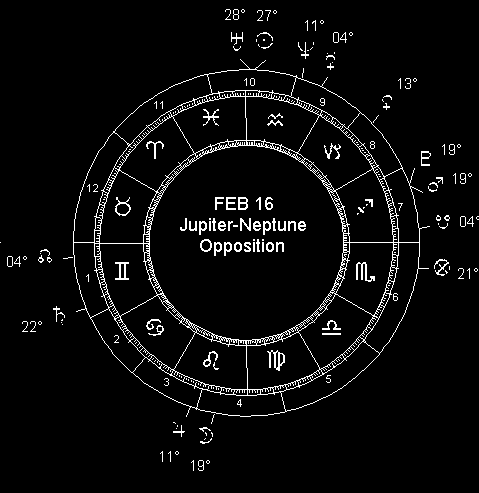 The Jupiter-Neptune opposition is nothing if not historic. It sits like bookends neatly bracketing Darius the Great's ruinous war against the Greek city states between 490 and 479 BCE; and is a close fit to the rise and fall of Alexander the Great between 336 and 323 BCE. The Libra-Aries opposition of 427 BCE occurred in the midst of the Peloponnesian War, when plague struck ancient Athens and killed a third of that city's population. Rome sacked Carthage in the year of a Jupiter-Neptune opposition from Gemini to Sagittarius, in a siege that ended the Punic Wars - and Carthage. Octavian defeated the armada of Antony and Cleopatra in the great naval battle of Actium in 31 BCE, the final year of a triple Pisces-Virgo opposition. If it means anything at all, this Jupiter-Neptune alignment portends ideological and religious misunderstanding, and a prideful refusal to compromise that ends up sacrificing people for principle.
The Jupiter-Neptune opposition is nothing if not historic. It sits like bookends neatly bracketing Darius the Great's ruinous war against the Greek city states between 490 and 479 BCE; and is a close fit to the rise and fall of Alexander the Great between 336 and 323 BCE. The Libra-Aries opposition of 427 BCE occurred in the midst of the Peloponnesian War, when plague struck ancient Athens and killed a third of that city's population. Rome sacked Carthage in the year of a Jupiter-Neptune opposition from Gemini to Sagittarius, in a siege that ended the Punic Wars - and Carthage. Octavian defeated the armada of Antony and Cleopatra in the great naval battle of Actium in 31 BCE, the final year of a triple Pisces-Virgo opposition. If it means anything at all, this Jupiter-Neptune alignment portends ideological and religious misunderstanding, and a prideful refusal to compromise that ends up sacrificing people for principle.
As I forecast for last year, gold has begun to climb under Jupiter's Leo sojourn, and this trend should continue overall through August 2003. (Of course there will be ups and downs, but the overall trend should take the precious metal to a price pinnacle not seen in many years.) The opposition from Jupiter to Neptune reinforces this positive trend for gold, and adds upward impetus to petroleum prices as well. It is, in a word, inflationary.
The upward bias in gold and oil prices presages a general inflationary trend, but countervailing forces should keep overall price indices from getting out of hand in 2003. In other words, 2003 shows a bit more inflation that 2002, but it's hardly in the runaway train category. For example, Saturn's transit through Cancer begins in June and continues into July 2005. This is not a good sign for real estate prices. It's probably not the bubble market collapse some prognosticators have forecast, although it could approach that in some real estate markets and regions. What with the sign Cancer being so prominent in the US national horoscope, this surely focuses on the American real estate market - and in particular the areas which have skyrocketed in value over the last several years. The dollar's decline relative to other major world currencies is another trend associated with the Saturn in Cancer transits. (Again, like the upward bias for gold and oil, this won't be a steady unbroken trend: it will have its ups and downs from day to day and week to week.) I fully realize that the mildly inflationary trend I foresee for 2003 runs counter to the general deflation predicted by some financial forecasters, including a few whose work I admire. Time will tell who's right and who's wrong.
Wars and rumors of wars not only play a big role in world financial markets and economies this year; they're a story unto themselves, and likely the biggest ones of the year. Notice, I'm using the plural here. While a war with Iraq is widely expected - and will surely happen, barring a pre-emptive coup that takes Saddam Hussein from power - that's not the only conflagration signaled by the celestial portents of 2003. Take the stubborn (deluded?) ideological intensity of a Jupiter-Neptune opposition, add a little of the warrior spirit, and you've got yourself the makings of a first class fracas.
Mars - named for the Roman warrior god and root of the word martial - is emphasized this year as never before in recorded history. When the Red Planet stands in opposition to the Sun at the end of August 2003, it will be just over 34-1/2 million miles from Earth - the closest these two planets have been in over 70,000 years. This is the culmination of a cosmic cycle which has been building toward a climax since the Neanderthals shared the planet with our ancestors.
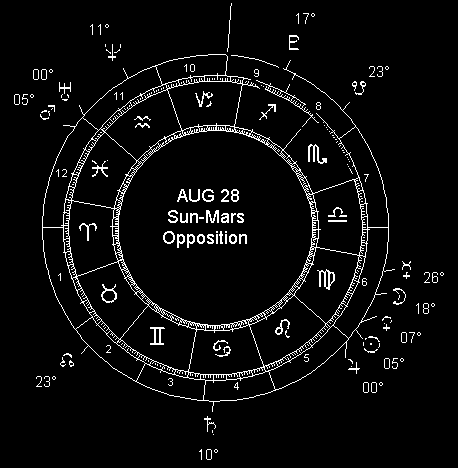 The heart of the matter is that Earth overtakes Mars in its orbit once every couple years or so, at which time the Sun, Earth and Mars are all aligned: this is the Sun-Mars opposition, as seen from Earth; and it's a nominal Mars perigee (the point in its orbit closest to Earth). Approximately once every fifteen years, this alignment happens at the same time Mars makes its closet approach to the Sun - its perihelion, in other words. At such an instance, Earth and Mars are much closer than the usual perigee. When the Mars perihelion and Sun- Mars opposition take place with Earth also at or near aphelion (maximum distance from the Sun), Earth and the Red Planet are as close as they get. That's what happens this summer, when Mars will loom brighter in the night sky than all the stars, outshone only by the Moon and Venus. Think of it as super Mars, and you get the picture.
The heart of the matter is that Earth overtakes Mars in its orbit once every couple years or so, at which time the Sun, Earth and Mars are all aligned: this is the Sun-Mars opposition, as seen from Earth; and it's a nominal Mars perigee (the point in its orbit closest to Earth). Approximately once every fifteen years, this alignment happens at the same time Mars makes its closet approach to the Sun - its perihelion, in other words. At such an instance, Earth and Mars are much closer than the usual perigee. When the Mars perihelion and Sun- Mars opposition take place with Earth also at or near aphelion (maximum distance from the Sun), Earth and the Red Planet are as close as they get. That's what happens this summer, when Mars will loom brighter in the night sky than all the stars, outshone only by the Moon and Venus. Think of it as super Mars, and you get the picture.
An extreme Mars like this, in the canon of astrology, points to all things martial coming to a peak here on Earth. While Mars certainly has some positive astrological connotations (courage, ardor, competition, ambition, strength, etc.), the negatives are a bit on the scary side: war, assault, attack, brutality, violence, etc. We were already headed into a high Mars 2003, what with the January and February Mars alignments with the eclipse points of late 2002, and the August Sun-Mars opposition - just to name a few of the strong Red Planet signals of 2003. Tossing in a Mars super perigee turns a strong simmer into a rolling, splashing boil-over.
January 14 brings Mars to the opposition point of the November 20, 2002 28 Taurus lunar eclipse (i.e. conjunct the Sun's 28 Scorpio position at that eclipse). Another Mars-eclipse activation follows in short order on February 4, when the Red Planet crosses over 12 Sagittarius (the location of the December 4 solar eclipse). Astrological tradition holds that, around these dates, the headlines will be replete with reports of conflict on both the personal and collective levels. From mano-a-mano street crime to murder and mayhem, to terrorism and military posturing and outright war, these are perilous times. Danger happens not only by design, but also by mishap under these Mars configurations: accidents, fires, crashes and explosions are par for the course. Look for all of them to make headlines within a few days either way of the many significant Mars phenomena of 2003.
Although anyone could be a potential target at times like these, there are a couple of astrological indicators that seem to fit the obvious trend toward another US-Iraq war. (Obvious now, perhaps not so obvious last year when I predicted that "a big offensive modeled after the Persian Gulf War" would come in 2003, "probably during Mars' Sagittarius transit (January 17 - March 4)". For one thing, the January 14 Mars-eclipse pass is in direct opposition to the Moon in Iraq's independence chart, and right on the ascendant in the US Constitution horoscope. For another, the February 4 Mars-eclipse pass falls on the ascendant in the US Declaration of Independence chart. The combination of the two looks for all the world like a sign of Gulf War II - or else a coup to overthrow Saddam Hussein in hopes of preventing a US attack. Either way, late January to early February looks like a time of peril for Iraq and the US. Aside from the aforementioned eclipse activations, the other Mars jolts upping the ante for conflict early in 2003 come around the Mars-Pluto conjunction of February 16 and the Mars-Saturn opposition of February 20 - the latter being the Mars configuration that held sway in the heavens during the Cuban Missile Crisis, of course.
The January-February Mars alignments cram a year's worth of conflict into just a few weeks. And because of the degrees involved being prominent in important national horoscopes of Iraq and the US, it's easy to extrapolate from current events to project a conflict between these two countries going critical early in the year: an attack, an assassination attempt, civilians and soldiers in harm's way, the whole martial mess.
And that's just the start, because 2003 features lots of notable Mars alignments - not unlike 2001, which gave us the World Trade Center attack. All the same Mars alignments of 2001 are repeated in 2003; Mars, after all, has a synodic period of a bit more than two years. The difference is the intensity associated with the Mars super perigee this time around, which puts an historic emphasis on the Mars transits of 2003. So watch for them, be on guard, steer clear of trouble and conflict as much as possible when the major Mars alignments of the year form out in space. Besides the January-February eclipse activations and alignments, additional strong Mars alignments signal danger and strife around May 8 and 14 (Mars opposite Jupiter and conjunct Neptune respectively), as well as June 23 (Mars conjunct Uranus). Give or take a few days either way, these are dates to play it safe as much as possible . . .
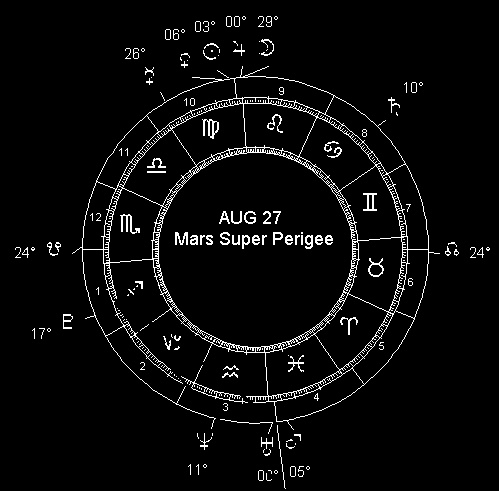 But the really big Mars deal doesn't happen until the Mars super perigee and Sun-Mars opposition at the end of August - at 09:51 UT on the 27th and 17:59 UT on the 28th, respectively. This super-Mars stuff happens in virtual simultaneity with a Mars-Uranus conjunction in-opposition to a new moon conjunct Venus and Jupiter; with Mercury and Pluto going stationary (retrograde and direct respectively) to boot. And that super perigee alignment, in the 5 Virgo-Pisces polarity, makes a curious set of contacts: to Mars in President Bush's natal chart (and his progressed Sun), to Saturn in North Korea's chart, Pluto in the UK and French horoscopes, Mars and Jupiter in the Canadian national horoscope, the Venus-Saturn opposition in Iran's Islamic Republic chart . . . lots of hits, all as Mars goes critical in the heavens as seen from Earth. Whoever thinks a swiftly concluded Persian Gulf War II settles the world into a Pax Americana early in 2003 is tragically mistaken. This late summer super Mars thing says peace and quiet remains far away, that danger and conflict are close at hand.
But the really big Mars deal doesn't happen until the Mars super perigee and Sun-Mars opposition at the end of August - at 09:51 UT on the 27th and 17:59 UT on the 28th, respectively. This super-Mars stuff happens in virtual simultaneity with a Mars-Uranus conjunction in-opposition to a new moon conjunct Venus and Jupiter; with Mercury and Pluto going stationary (retrograde and direct respectively) to boot. And that super perigee alignment, in the 5 Virgo-Pisces polarity, makes a curious set of contacts: to Mars in President Bush's natal chart (and his progressed Sun), to Saturn in North Korea's chart, Pluto in the UK and French horoscopes, Mars and Jupiter in the Canadian national horoscope, the Venus-Saturn opposition in Iran's Islamic Republic chart . . . lots of hits, all as Mars goes critical in the heavens as seen from Earth. Whoever thinks a swiftly concluded Persian Gulf War II settles the world into a Pax Americana early in 2003 is tragically mistaken. This late summer super Mars thing says peace and quiet remains far away, that danger and conflict are close at hand.
There's one more chart of particular interest at this time in history; namely the chart for Islam itself (set for Mohammed's arrival in Medina). In that horoscope, the Mars super perigee falls right across a Jupiter-Neptune opposition - the latter aspect appearing again in 2003 as it did at the foundation of Islam in 622. It's unprecedented, so who could know what all this means? I suspect it points to some kind of attack at least as big as the January-February clash. And this time around, the attack seems to focus on technical and economic infrastructure (e.g. computer and network assaults) - or uses highly advanced military weaponry. It seems highly likely that one focus of this is the war between Islamists and Western civilization: a major terror attack, a significant reprisal, something of that sort.
As the Red Planet pulls away from its close approach to Earth at the end of August, it still manages to form a couple of major alignments before year's end; namely, a pair of follow-ups to its May 8 opposition to Jupiter. These occur at 2 Pisces-Virgo on September 7 and 16 Pisces-Virgo on November 20.
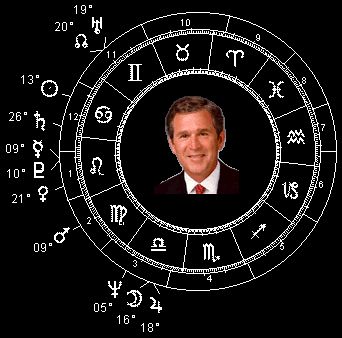 Having a 'three-peat' Mars-Jupiter opposition with two of the three alignments in the Virgo-Pisces polarity, as well as the Sun-Mars opposition with Mars at super perigee in this same polarity, puts a special emphasis on the horoscopes of people and nations with significant placements in these degrees. Among the national targets must be counted Argentina, Brazil, China, France, Germany, Iran, Iraq, North Korea, Mexico (death in plain sight), Russia, the UK, the US and Venezuela. Canada is especially singled out, it seems to me, because the 1867 independence chart features a Virgo-Pisces Mars-Jupiter opposition: labor strife, a crime spree, a public health crisis of some kind. And of course there's the US, where as noted President Bush's natal Mars is in the crosshairs (also the Sun-Saturn conjunction in the US Constitution chart).
Having a 'three-peat' Mars-Jupiter opposition with two of the three alignments in the Virgo-Pisces polarity, as well as the Sun-Mars opposition with Mars at super perigee in this same polarity, puts a special emphasis on the horoscopes of people and nations with significant placements in these degrees. Among the national targets must be counted Argentina, Brazil, China, France, Germany, Iran, Iraq, North Korea, Mexico (death in plain sight), Russia, the UK, the US and Venezuela. Canada is especially singled out, it seems to me, because the 1867 independence chart features a Virgo-Pisces Mars-Jupiter opposition: labor strife, a crime spree, a public health crisis of some kind. And of course there's the US, where as noted President Bush's natal Mars is in the crosshairs (also the Sun-Saturn conjunction in the US Constitution chart).
The eclipses and SuperMoons of 2003 also bear watching, in addition to the major planetary alignments. There are four eclipses in 2003, two solar and two lunar; all in the Taurus-Scorpio and Gemini-Sagittarius polarity. (The Gemini-Sagittarius pair are the last in this sign series for seven years.)
The first of the year's eclipses is the total lunar eclipse at 25 Scorpio on May 16 (with Mars conjunct Neptune and opposing Jupiter). This eclipse belongs to Saros Series 121, which began in 1029 (at a time when the Danish King Canute established a Northern Empire encompassing all of Scandinavia as well as England), and ends in 2526. It also happens to be a SuperMoons, term I coined in a 1979 article for Dell HOROSCOPE magazine to indicate a new or full moon (syzygy) which occurs when the Moon is at or very near (90% of) the closest point (perigee) in its orbit around Earth. The entire eclipse is visible in eastern North America, and all of Central and South America plus Antarctica; portions of the eclipse can be seen in Africa, the Middle East and Europe plus western North America. As with all eclipses, this one ups the ante for strong storms, coastal tidal flooding and inland flooding due to heavy precipitation; also moderate to severe seismic activity (including Richter 5+ earthquakes as well as volcanic eruptions). And because it's a SuperMoon, the storm, flood and seismic potential is especially intense. The risk window for these SuperMoon eclipse accoutrements in this case is May 13-19. Eclipses are planet-wide in potential scope, so the aforementioned geophysical shock factors could manifest virtually anywhere on Earth. Still, the maximum visibility zone and the astro-locality map for this eclipse do seem to focus on eastern South America and the very northeastern tip of Canada on up into western Greenland. Also, a north-south line from Hawaii up into Alaska and through Central Africa and Eastern Europe appear to be in the danger zone this time around.
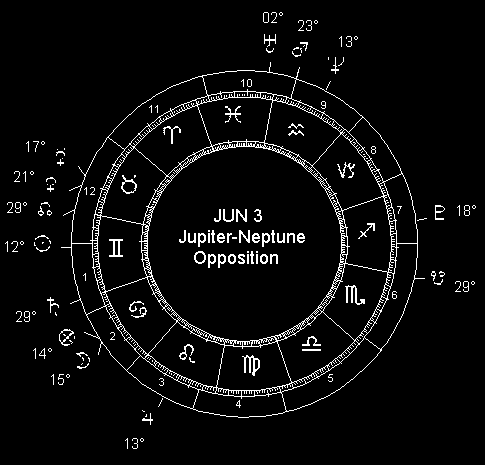 Next up is the annular solar eclipse at 9 Gemini on May 31 (with Jupiter opposing Neptune). This is the first central eclipse in Saros Series 147, which began in 1624 (a time of rapidly expanding European colonialism, as well as the middle of the Thirty Years War, the last of Europe's great religious conflicts). The series concludes in 3049. Series 147 eclipses all occur at or near the north lunar node, and their zone of visibility moves southward over time. The full eclipse is visible only from Scotland, Iceland and Greenland; but partial phases can be seen in parts of the Middle East, Africa, and Europe; and in the Western hemisphere, from northern Canada and parts of Alaska. These areas must be considered high on the list of zones where storms, flooding and seismic activity will likely be prominent during the solar eclipse window of vulnerability, from May 24 through June 7. Astro-locality mapping suggests that particular risk zones include western Alaska, the Aleutian Islands and the Bering Strait as well as a north-south line running from Copenhagen down through Rome and into Lebanon and along the southwest coast of Africa.
Next up is the annular solar eclipse at 9 Gemini on May 31 (with Jupiter opposing Neptune). This is the first central eclipse in Saros Series 147, which began in 1624 (a time of rapidly expanding European colonialism, as well as the middle of the Thirty Years War, the last of Europe's great religious conflicts). The series concludes in 3049. Series 147 eclipses all occur at or near the north lunar node, and their zone of visibility moves southward over time. The full eclipse is visible only from Scotland, Iceland and Greenland; but partial phases can be seen in parts of the Middle East, Africa, and Europe; and in the Western hemisphere, from northern Canada and parts of Alaska. These areas must be considered high on the list of zones where storms, flooding and seismic activity will likely be prominent during the solar eclipse window of vulnerability, from May 24 through June 7. Astro-locality mapping suggests that particular risk zones include western Alaska, the Aleutian Islands and the Bering Strait as well as a north-south line running from Copenhagen down through Rome and into Lebanon and along the southwest coast of Africa.
The total lunar eclipse at 16 Taurus on November 9 is the last total type in Saros Series 126, which began in 1210 (during the ascendancy of Genghis Khan in the East, and the Roman Papacy in the West), and ends in 2490. The entire eclipse will be visible over Europe, most of Africa, Greenland and the eastern Americas; while portions of the eclipse can be seen in parts of Asia and western North America. Remembering that eclipse portents are global in nature, you can figure that all of Planet Earth is under a storm, flood and seismic watch during the November 6-12 lunar eclipse window. If there are any areas of special vulnerability, the areas where the entire eclipse is visible should rank high on the list. In particular, there's a north-south line running through the eastern US and Canada, down into Central America, which looks like a danger zone; also a suspicious-looking north-south line from Moscow down through Addis Ababa.
Last but hardly least is the total solar eclipse at 1 Sagittarius on November 23. This particular eclipse belongs to Saros Series 152, which began in 1805 (the year an earthquake killed thousands in Naples, Mehemet Ali effectively took Egypt out of the Turkish Empire and into a socialist economy; and the Napoleonic Wars were raging - the largest naval engagement of which was Nelson's epic but costly victory at Trafalgar, establishing British naval superiority for a century). This series ends in 3049. The potential for strong storms, flooding and moderate to severe seismic events (including Richter 5+ tremors as well as volcanic eruptions) is especially pronounced with this eclipse, because it also happens to be a SuperMoon. Watch, and you'll see natural upheaval making an extraordinary number of headlines during this geophysical risk window, November 16-30. As always, because this alignment is planetary in scale, there's no place on Earth that's entirely safe from the kind of natural havoc described here. Still, the zone of eclipse totality - which includes Antarctica and mostly open ocean - is likely to be a special focus. And since the eclipse will also be visible (albeit only partial) from New Zealand, Australia, southern Argentina and Chile, these areas too may be at special risk; especially Argentina and Australia, I should think, judging from the eclipse astro-locality map.
There are a total of five SuperMoons in 2003, including the two already mentioned which also happen to be eclipses: the May 16 lunar eclipse and the November 23 solar eclipse. (A SuperMoon, as I've already indicated, is a new or full moon [syzygy] which occurs when the Moon is at or very near [at least 90% of] the closest point [perigee] in its orbit around Earth.) A garden variety SuperMoon is easily as important as an eclipse in terms of signaling storm, flood and seismic risk; and so these unusual alignments also bear watching.
The year's first SuperMoon is the April 16 full moon at 26 Libra. Watch for headline-grabbing storms, flooding and seismicity (including Ricther 5+ quakes and volcanic eruptions) April 13-19. As with all such geocosmic alignments, a SuperMoon is planetary in scale, so there's no place on Earth beyond its scope. Still, astro-locality maps out a few target zones of possible special risk this time around. These include southwestern Alaska, a north-south line running through Alberta, down into Montana and Idaho, roughly along the Utah-Nevada border, along the Colorado River and down through Baja California. (Halfway 'round the world, a mirror image north-south line runs through Pakistan and Afghanistan up into Russia.) And then there's the Mars line running through China and India . . .
The October 25 new moon at 2 Scorpio looks like a huge storm and flood signal from the 22nd through the 28th; although this SuperMoon will also have its seismic accompaniment, I'm sure. Watch the west coast of Africa for big storms, and on a line from there due north through Iceland. Some kind of costly damage - most likely from storms, but seismicity may figure into it as well - is a genuine risk in northern California and the Pacific Northwest. Other potential target zones include New Zealand, southern Japan and the Korean Peninsula, as well as the area along a line stretching due north from the western coast of Australia up through Indonesia and Hong Kong. But again, these astro-locality danger zones are only suggestive: this thing is planetary in scale and no place on Earth is beyond the reach of severe weather and/or seismic upheaval.
The last SuperMoon of the year is the December 23 new moon at 1 Capricorn, which pretty well ensures a "White Christmas" for a lot of people because it's in effect December 20-26. Of course the whole world is subject to the storm and flood and seismic risk associated with this alignment, but astro-locality maps out a few areas which may be especially under the gun this time around. These zones include east Africa and the Middle East, eastern Australia, the Philippines, southern Japan and eastern China; also Alaska, easternmost Canada, Great Britain and Scandinavia.
In closing, it simply wouldn't do to neglect the Mercury and Mars retrogrades of 2003. Mercury retrogrades are good for fixing up mistakes, because they're so plentiful then. Be on the lookout for Murphy's Law reigning supreme during the four Mercury retrogrades of 2003: January 2 to 23, April 26 to May 20, August 28 to September 20, and December 17, 2003 to January 6, 2004. These are times when double-checking everything and assuming that nothing goes right without constant guidance is pretty much the only way to go. And even then, there are bound to be snafus aplenty. Printing, transportation and communication are fertile ground for all such mishaps: allow extra time and plan on extra effort. The good thing about a Mercury retrograde is that it's great for reviewing works in progress (or previously abandoned for lack of success) to find and fix elusive flaws. And then there's the Mars retrograde, something that only happens every other year. It always comes at a time of heightened Mars significance, including as it does the Sun-Mars opposition and Mars perigee. It's just one more reason 2003 won't go quietly, especially while the Red Planet goes retrograde from July 29 to September 27.
ACKNOWLEDGMENTS: All astrological charts as well as eclipse and astro-locality maps were calculated and produced using Matrix Software's WinStar.
